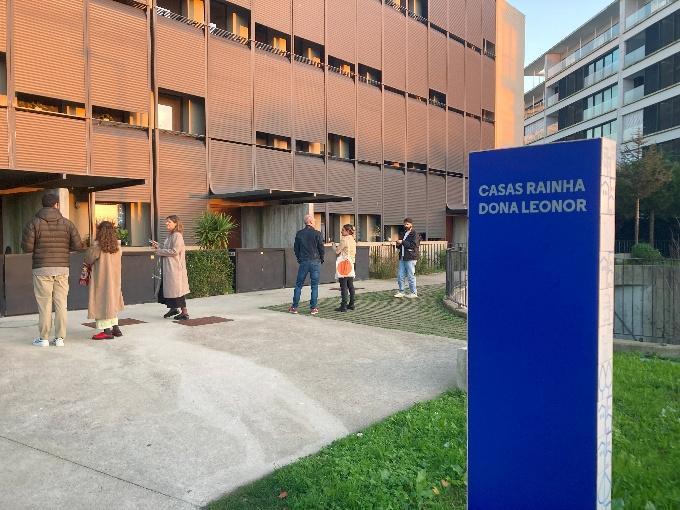By Sara Neves
Between November and December 2024, a team of four colleagues from Domus Social (Porto, Portugal) travelled to Denmark for a two-week study visit. The team was composed of staff from four different departments — legal, tenant management, project management, and research & planning — to encourage a multidisciplinary exchange of perspectives and a more comprehensive understanding of Danish practices.
As representatives of a local public administration company, responsible for managing around 13,000 homes (roughly 12% of the housing stock in the city), and serving about 30,000 tenants, the main goal of the visit was to gain practical insights for improving social housing in Porto. To achieve this, a field-based survey approach was adopted, made possible through the support of various local institutions — from academia to housing providers — who offered essential historical, conceptual, and operational context regarding Non-Profit Housing (NPH) in Denmark while guiding visits to real-life case studies.
The journey began in the city of Aalborg, hosted by the Himmerland Housing Association and the planning and housing departments of the Aalborg Kommune. In Copenhagen, valuable insights and guidance were provided by Aalborg University, the housing association KAB (Københavns Almennyttige Boligselskab), and BL – Boligselskabernes Landsorganisation – the Danish Federation of Non-Profit Housing Providers.
From this experience, we gathered useful practices that could be applied in the Portuguese context, such as:
Size of the NPH stock
Lesson re-leaned: we need more non-profit housing. The tangible impact of Denmark’s high percentage of affordable housing (~20%) compared to Portugal’s (~3%) is a well-known topic, yet one that is even more evident on the ground. Particularly interesting to witness is how this housing is geographically distributed: it is present in all Danish Municipalities and not limited to metropolitan areas. Furthermore, it is also worth noting the set of active measures in force, which shows that maintaining a high level of NPH requires continuous commitment. One such measure is the urban development regulation allowing municipalities to require up to 25% social housing in new residential areas. This measure, however, also highlights cross-cutting aspects of the housing crisis affecting Europe. As we learned from local stakeholders, its effective implementation has been challenging and had limited success, especially in areas with heated housing markets such as Copenhagen, due to factors like the high cost of land — which is often unaffordable for housing associations. A similar scheme, on a much smaller scale, exists in Portugal. How can we implement this measure effectively?
Spatialization of the NPH stock
Although non-profit housing in Denmark is distributed across all municipalities, it has often been concentrated in large clusters, sometimes comprising thousands of units — ostensibly to ensure “effective management”. Over the years, this model has drawn criticism—echoing some of the concerns seen in Portugal in the second half of the 20th century about functionally segregated urban landscapes, sometimes marked by a lack of essential services and poor accessibility, resulting in social and economic isolation that tends to perpetuate cycles of vulnerability and stigmatization. In response to this, in the last decade, the Danish government has introduced the “Ghetto Package” (later renamed the “Parallel Society Act”) to identify a list of areas requiring a more radical physical and social intervention. This legislative framework, very broadly focused on diversifying ownership models, diversifying land/building use types and implementing social programs in those areas, has raised serious concerns about social labelling and systemic discrimination. This is mainly due to the use of demographic and socio-economic criteria to designate these areas — including the percentage of “non-Western” tenants and their descendants, often resulting, in their displacement to achieve the “appropriate population group quotas” in housing complexes. There are some cases, however, that demonstrate that displacement is not always necessary, and the desired outcomes can be achieved through densification instead. Nonetheless, group discrimination is always there, as well as the breaching of the cornerstone of the Danish housing sector: tenant democracy. Given that Portugal also has large social housing estates where challenging socio-spatial conflicts have been identified, how can we mirror Denmark’s proactivity—channelling funds and resources into regenerating these areas—without repeating the same ethical failures? What socio-spatial regeneration model can we build together to address this shared urban challenge?
Management of the NPH stock
Denmark presents a well-coordinated, pluralistic ecosystem for affordable housing, involving public, non-profit, and private actors at national, municipal, and community levels. Within this mature and finely tuned framework, two entities stand out when compared to the Portuguese context. First, Housing Associations—responsible for building and managing NPH complexes—ensure inclusive governance: tenants sit on democratically elected boards and make decisions about their housing and neighbourhoods. Tenant democracy is (or used to be?) strong—no major renovation or other changes occur without resident approval. Second, the National Building Fund (NBF), a state-regulated body, guarantees the sustainable ongoing improvement of these homes: it prioritizes and finances the renovation of all NPH complexes. Rents in NPH, calculated based on construction and maintenance costs, feed this fund, while housing subsidies — drawn from other public sources and granted according to family needs — help support some of these rents. Additionally, an inspiring key feature of this ecosystem’s functioning is transparency: information about various aspects of the sector is publicly accessible, and citizens can, in an informed manner, choose how to participate in it. Points for rhetorical reflection: Would a stronger presence of community based non-profit players help build a healthier housing ecosystem in Portugal? Would a national fund, dedicated solely to housing, help address geographical inequalities in access to social housing in Portugal? Would a housing model grounded in transparency, tenant democracy, and coordinated financing empower the most vulnerable to make their own informed, sustainable choices about housing and take responsibility for it?
Quality of the NPH stock
The ongoing upkeep of housing quality in Denmark provides valuable insights worth emulating. Over decades, small-scale improvements—on walls and roofs—gradually evolved into deeper interventions, including façade duplication and window replacement, the redesign of outdoor spaces, and ultimately, reintegration into the surrounding urban fabric. Comfort is visibly a priority. Thermal, acoustic, olfactory, visual — enhanced by growing efforts to ensure the presence of greenery. Well-maintained wild greenery, replacing manicured lawns and symmetrical flowerbeds. Comfort in access, both inside and outside the home — for people with reduced mobility, as well as for any pedestrian or cyclist. Never forgetting low levels of traffic and noise pollution. But what, ultimately, impressed us in a more synesthetic way is how outdoor spaces are not only transitional voids but meaningful liveable environments — designed and maintained with care, down to the smallest interstice. Each bench, each path, each patch of green is an invitation to linger. No detail is too small to be made pleasant. It would be interesting to conduct a comparative study on the number of public benches per equivalent area in Porto and Copenhagen.
Final Reflections
Firstly, mixing experiences from home and abroad, this visit served as a powerful reminder that urban innovation often emerges from strong cooperation, community bonds, trust in citizen participation, and an intersectoral perspective on urban living.
Moreover, despite differences in scale and context, we acknowledge that many of the current housing challenges faced in Denmark are shared in Portugal. The housing crisis is an interconnected phenomenon. Its manifestations are likely more similar between metropolises in different countries than between a metropolis and a small, low-density village within the same country. And these interconnections go beyond Europe. The housing crisis must be understood within the contours of interconnected planetary urbanization.
Furthermore, it’s always worth highlighting the benefits of programmes like DASH. By bridging not only different geographic contexts but also various institutional spheres, we enable a deeper understanding of each region’s, country’s, city’s, and neighbourhood’s housing system, and foster active engagement in critical, forward-looking discussions. This secondment was not a one-sided learning process — it happens as our Danish, German, and Serbian colleagues visit us to be inspired by our best practices and improve their own. Through critical discussions of both experiences, new possible courses of action emerge. Ultimately, we come closer to hacking the dominant dynamics that are intensifying the global polarization of housing conditions.

